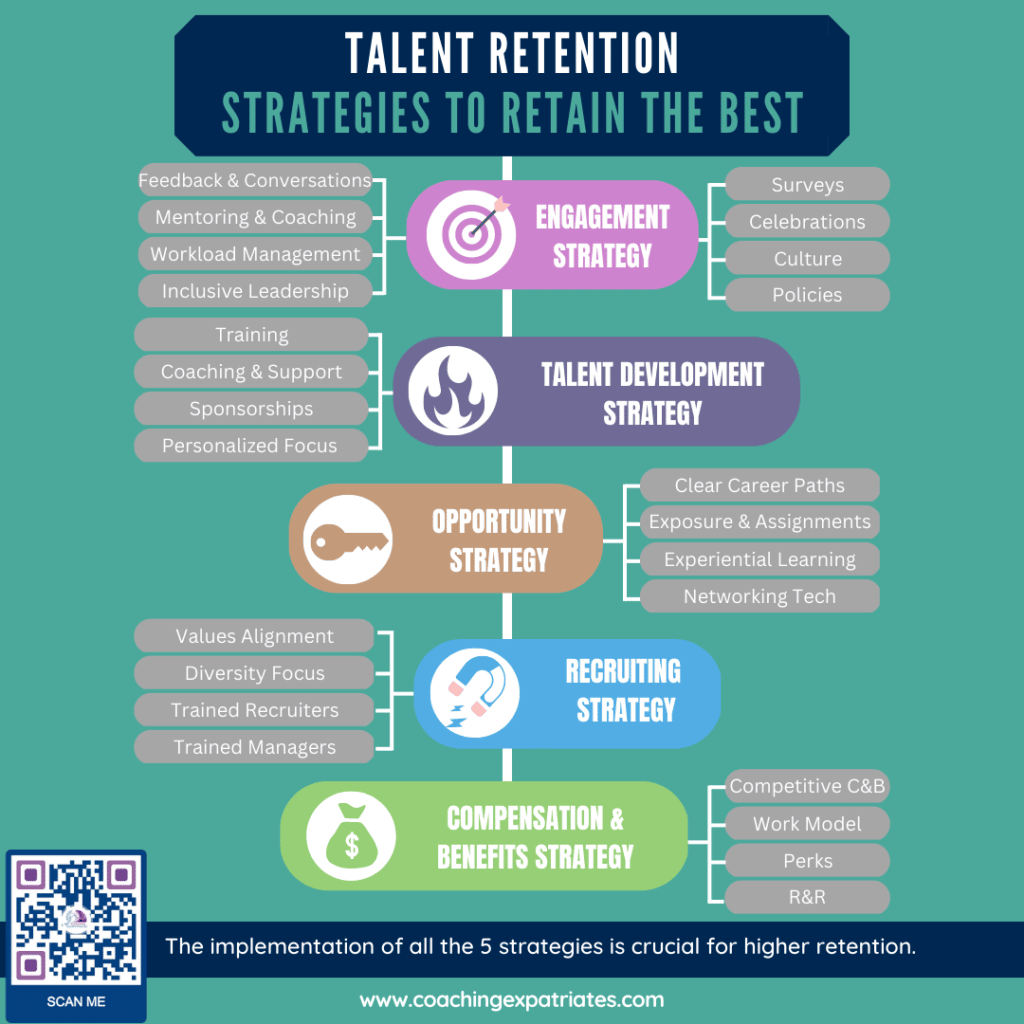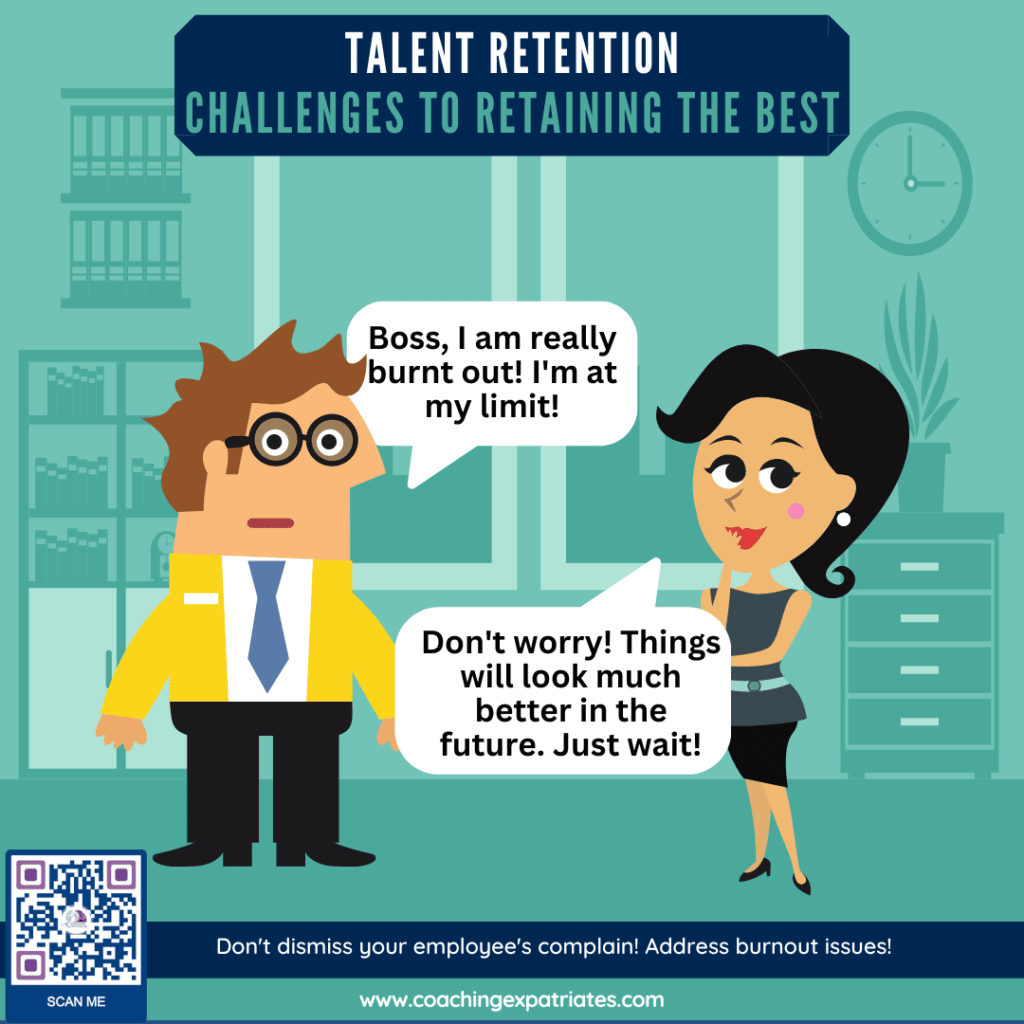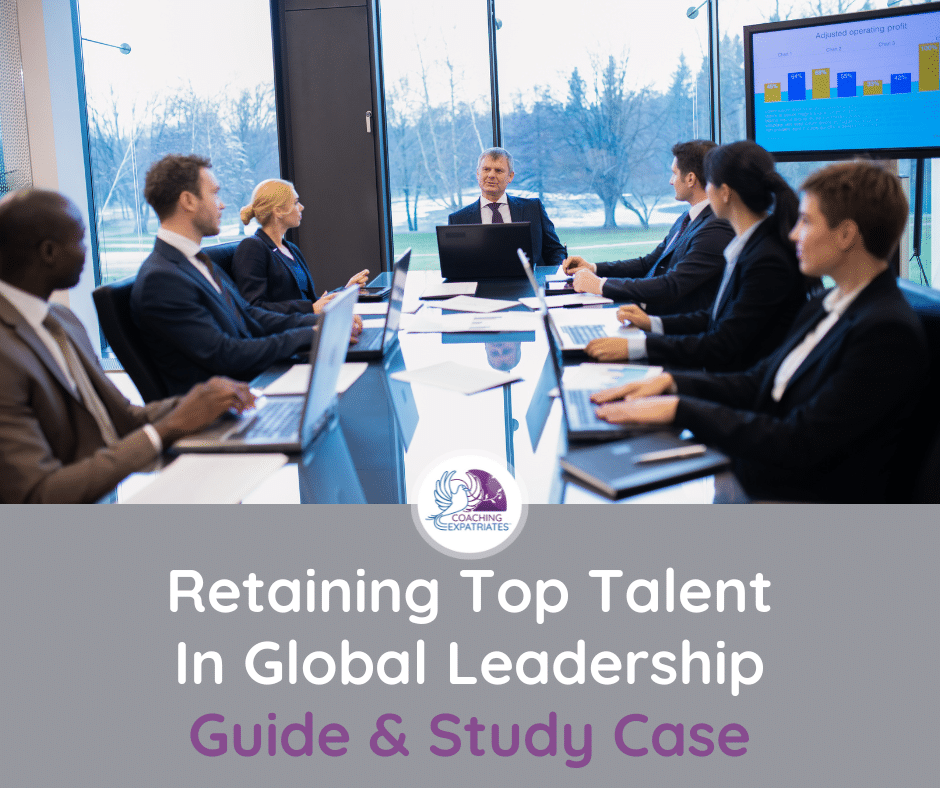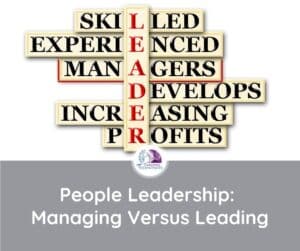Retaining the best and brightest talent in global leadership roles is challenging for any company. With the right strategies and approaches, companies and their leadership team can ensure they are recruiting top-level employees and successfully retaining them through a solid talent strategy.
The competition to attract and retain the best talent has never been as fierce as today. In a globalized world, companies have to worry about competing with other organizations worldwide and ensuring top talent stays loyal without sacrificing their work-life balance and growth opportunities.
Talent retention and engagement are the second top priority for business leaders, only behind the complex challenges of building effective global leadership. According to Deloitte, “the issues of [talent] retention and engagement have risen to No. 2 in the minds of business leaders, second only to the challenge of building global leadership.”
Why Would Global Executives Want to Retain Their Top Talents
There are many reasons why executives would want to retain their top talented employees, but the main three boil down to adding more value to the shareholders at the end of the day. Let’s deep dive into them:
Provides Higher Employee Productivity
Top talents are more productive and focused on what they are doing. Their drive to get things done is greater than the average, so they achieve more than the regular employee. A recent study, shared by McKinsey, of more than 600,000 researchers, entertainers, politicians, and athletes found that high performers are 400 percent more productive than average ones.
Similar research into business practices demonstrates the same outcome, additionally showing an increase in the discrepancy based on the job’s complexity. The top 10 percent of employees in complicated roles, such as managers and software developers, are a remarkable 800 percent more productive than the least successful 10 percent.
Creates More Profitable Bottom Lines
Sharp, focused, and talented employees will inevitably produce better bottom lines. The “bottom line” is the corporate jargon used to refer to companies’ profits at the end of the year. Top talented employees will engage in fewer errors and omissions, drive more innovative initiatives, attend to the right priorities and make better decisions, which all lead to higher profits.
Many top talents also have attention to detail by learning skills that are not exactly in their main sphere of influence, but that provide greater support to their activities. It’s the case of many top executives improving their financial literacy, which helps them make financial decisions more effectively and drive initiatives that will have a greater return on investment.
Reduces Employee Turnover Rates And Backfilling Costs
Based on the Bureau Of Labor Statistics data, the general turnover in the US was a staggering 47.2% in 2021 and had been showing an upward trend long before the pandemic. This is backed up by a recent CNBC report showing that 96% of the US workforce is looking for a new job in 2023.
If you ask any experienced HR, they will tell you how hard and costly it is to backfill a position. The more complex a position is, the harder and more costly it becomes to backfill it.
The cost of replacing employees is translated into the recruiting process, onboarding process, functional training, and cultural acclimation, which all might be longer or shorter depending on the employee’s experience and background. Each step in this process involves costs from suppliers hired to do specific tasks and other company employees fulfilling tasks in these processes. The more time internal employees spend focusing on these tasks, the less time they will have to tackle other priorities. And that’s how costs also add up.
According to a study, the manager accounts for at least 70% of the variance in employee engagement. This means that when surveying companies with high employee engagement and low employee engagement and their respective turnovers, it was found the manager had an outstanding contribution to the overall employee engagement, which closely reflected turnover rates. This means that retaining talented managers has the effect of cascading talent retention in the overall organization, reducing total backfilling costs.
What Are The Main Areas Business Leaders Need To Focus On For Retaining Top Talent
To make the next session easier to consume, we will put concepts in a model with categories to help you better understand this topic of retaining top talent. Employee retention initiatives fall under 5 main categories:
- Recruiting
- Compensation & Benefits
- Education
- Opportunities
- Engagement
These categories follow the employee’s cycle inside the company. Every employee is attracted to a company, selected through a recruiting process, paid and trained to do a job, given certain opportunities to progress in their careers, and engaged in loving and caring for what they do and the company. If this cycle is done right, they stay longer with the company. If faulty, the employee will look for a job elsewhere.
5 Proven Strategies For Retaining Top Talent In Global Leadership
According to the main categories we outlined, there are specific business models, strategies, and actions that each company has to work on to retain its top talents.
Recruiting Strategy
- Recruit Based On Company Value Alignment: it’s important to bring people with the right credentials and experiences to work for you. But it’s even more important that you hire the right people that have values aligned with the company culture and that will fit in the cultural mindset of this company. For example, if your company promotes collaboration, you don’t want to hire someone who has an aggressive profile and that have a reputation for backstabbing other people to grow in their careers.
- Focus On Diversity: the more diverse teams are, the greater they perform together after completing the team formation process. This has to do with the fact that different perspectives and opinions bring more innovation, creativity, and appealing solutions. On top of that, diverse teams prevent specific groups from standing out and being bullied for their differences. When everyone is different, everyone is equal. It’s easier retaining top talent when they don’t feel singled out.
- Create Trained Recruiters: a trained recruiter is different from an experienced recruiter. Trained recruiters have the highest business acumen possible to pinpoint and select the best talent in the market aligned with company culture, values, and needs.
- Develop Trained Hiring Managers: managers might be awesome at what they do, but this does not translate into knowing how to recruit the right people for their organizations. Training them on how to recruit the right people, how to make inquisitive questions that bring up the value in each candidate, how to avoid unconscious bias during the recruiting process, how to prepare for the interview, and how to select based on values, not only credentials, is crucial for a solid recruiting strategy. Well-trained hiring managers in recruiting will have half the battle won when retaining top talent.
Talent Development Strategy
- Provide Functional Training: when you hire a person for a job description, you assume that they know how to perform the activities in their functions. However, by providing expert functional training, you are boosting your employee’s capabilities to perform, helping them see new ways to perform their tasks and learn best practices in the market. This well-paid investment will yield a high return on investment, including employee retention. People stay when they feel supported to top perform.
- Offer Executive Training: many companies wait for their employees to reach a leading position before providing any executive training. And even when they do, they provide limited training focused primarily on people leadership, when they should be focusing on The 4 Success Pillars™ in global leadership. Employees who engage in complete training like this can grow faster because they understand what aspects of their performance they need to focus on, in order to bring value to the company. This type of training provides a long-term return on investment, but it’s exceptionally high-yielding, especially if the company has a well-established succession planning workflow. When you have good succession planning strategy, retaining top talent that is in your succession planning list is imperative.
- Share Training Support: employees want to know they will be supported with the proper training to succeed. Sometimes, this support comes in the form of money, but sometimes in the form of connections, opportunities, and assignments. People stay when they feel supported.
- Provide Professional Executive Coaching: aligned with the previous topic, sometimes employees need an outsider to help them bounce back ideas, plan projects and ensure consistency in development actions. Providing professional coaching for different needs can be a powerful tool to help your employee feel engaged and supported for the right development.
- Invest In Educational Sponsorships: sometimes, employees want formal and higher education. By setting aside some budget for educational sponsorship, you help your employees develop their knowledge and improve their credentials, trustworthiness, and employability, which will, in turn, translate into greater loyalty to the company.
- Give Personalized Training: some employees feel engaged when learning things both in their jobs and outside their main expertise. Many employees nowadays are looking to expand their skills outside their main job descriptions. In a 2018 Global Leadership forecast, modern workers reported wanting personalized learning and development from their employers.
Opportunities Strategy
- Create Career Paths: by providing clear career paths, employees can understand how they can grow in their verticals and how they could grow in lateral verticals, should they make a lateral transition. For example, a clear path in a finance department will determine the career path in the different subdivisions of finance, like Cash Management, FP&A, Commercial Finance, etc. Providing specific requirements for each path stepping-stone is vital to make it clear and actionable. Retaining top talent becomes much easier when they are focused on succeeding in their career paths instead of chasing new positions in the market.
- Invest In Special Assignments: many people gain experience and extra knowledge by taking special assignments. These assignments can be inside their current function, in a lateral position, in a different department, or even in a foreign country. The duration of these assignments can vary too, for example, short-term, long-term, and international assignments as an expatriate. Employees who feel their companies are providing them a competitive edge to improve their employability will be more engaged in that company.
- Instigate Experiential Learning: on the job training is something widespread in many medical and mental health fields. Experiential training requires a sound system of mentoring and support from senior executives. They can be incredible for fast employee development and growth. Many times, they can be framed as a special assignment and rewarded upon completion.
- Offer Exposure: helping your employees connect with the senior leadership, C-suite executives and influential stakeholders in the company help them become more engaged and tuned in for opportunities. Succession planning becomes easier too. Companies with formal exposure and networking system attract employees looking to grow and learn, while also retaining top talent. Some programs in this strategy could be a mentoring program, networking program, shadowing program, or accountability partners program.
- Provide Digital Technologies For Networking: more and more employees are turning to technologies such as Discord and forums to network and learn from their peers and seniors. Pairing this strategy with exposure programs and even special assignments can be fantastic for fostering a culture of growth and collaboration among employees. On top of that, employees who feel they belong to a network will feel more engaged and willing to stay at the organization since they won’t want to lose this special benefit.
Engagement Strategies
- Instigate Feedback Sessions: allowing your employees to gauge their performances in an emotionally intelligent way can be crucial for retention. All employees are learning, no matter their level of experience, expertise, and business acumen. Every one of us is always learning, so feedbacks are inevitable. The critical point is to share constructive feedback valuable to their careers and engagement.
- Foster Celebrations: celebrations can be powerful in promoting engagement and collaborative culture, while helping with employee exposure. Not all employees want to gain exposure in celebrations, but celebrations can be compelling in helping employees feel valued and recognized by the company, their peers, and their stakeholders.
- Do Surveys And Take Action: employee pulses and surveys can help companies understand what’s going on in the workforce’s minds. It allows organizations to create the right initiatives aligned with want employees want and will be engaged in. Today, technology made this super easy and cost-effective, so it’s infrequent to see a company that does not have it. The strategy, though, is not the survey but what you do with the survey. Taking action on what you learned in the survey is crucial for this strategy to have the engagement and retention effect the company wants.
- Create Performance Conversations: sometimes also known as performance reviews, performance conversations are essential for employees to understand where they are at and where they are going to. Unfortunately, most performance conversations have the wrong mindset since they focus on improving employee productivity and performance. And that’s why many employees fear for their work security every time they enter this kind of session. When they fear a performance conversation will go south, they already start looking for another job. Many times, though, they get the completely wrong idea because the manager was not trained to effectively manage their employees’ expectations between each session. If retaining top talent matters to you, a performance conversation must have a primary goal to help your employee feel happy and succeed in the company, and managers must be trained to do that. Performance and productivity are secondary to that.
- Provide Mentoring & Coaching: not every employee believes or understands the power of coaching and mentoring programs. And this is mostly because they never experienced a good one firsthand. Providing good programs that support their career, performance, and happiness can be a powerful ally in retention.
- Invest In Effective Workload Management: no one wants to stay in a company where they feel they are being slaved, taken advantage of, and overworked. Managing the workload effectively is imperative to make employees feel respected, valued, and well cared for. For that, the leadership team in the company must be well-trained in workload management. This type of training must be provided from the C-suite executives and most senior leaders to the most basic team leader.
- Create Inclusive Policies: creating policies that support a workplace of inclusion, belonging, and happiness is crucial to retain top talents in the market. People want to feel that they belong, no matter their differences, backgrounds, and aspirations. To achieve that, the company must have a robust system to collect information from their employees, such as pulses and surveys mentioned before.
- Ensure Well-Trained And Inclusive Leaders: if you have great inclusive policies but leaders who don’t abide by them, the company’s initiatives will fall flat, and employees will leave and will not feel ashamed to write an awful review on Glassdoor. Companies have to walk the talk, and inclusive policies must be paired with inclusive leaders with an inclusive mindset and a 4 Pillar executive training. This way, they will lead by example and make employees feel that they can trust in the word and actions of their leadership.
- Develop A Purposeful Culture: when employees are hired for an exciting job, but during onboarding and later stages of the employee cycle, learn the culture to be fake or to have no purpose; this will dramatically reduce their engagement levels. Assuming the other 4 categories in the retention strategy are taken care of (like hiring the right people, having good compensation, robust training, and opportunities), working on a purposeful culture can be a make or break in employee retention. People want to know what their doing counts for something, is worth their effort, and makes them proud.
Compensation & Benefits Strategy
- Develop Competitive Pay: anyone looking into LinkedIn research on compensation will read in the comments that they would rather pay for their family’s food than work for a company with an incredible culture while starving. Pay is still an important deciding factor when an employee wants to leave a company. Providing a competitive pack can be crucial to ensure all other strategies are well supported by at least fair compensation.
- Create Attractive Benefits Package: in the same line, attractive benefits will help your employee decide quickly whether or not to leave. For example, most employees won’t leave for a small increment in pay if they have a long-term fat bonus in the following years or a highly matched pension plan. However, attractive packages can be a double edge sword: doing a good job in talent management by keeping the top talents and weeding out employees who don’t perform is absolutely crucial. Otherwise, crooked employees will stay for the package, and your overall company’s performance will deteriorate over time.
- Include Employee Perks: although not the main deciding factor for retention, many employees are attracted by good perks. When these perks serve a greater purpose of helping your employee manage their lives, health, and families better, you help them focus on what matters, and everyone wins in the process.
- Provide Flexible Work Model Options: flexibility was always one of the most important aspects of retention, but it became even more prominent after the COVID-19 pandemic. Gartner divides flexibility into 3 categories: “work method,” which relates to employee autonomy, “temporal,” which relates to flexible working hours, and “locational,” which relates to flexible work locations. According to a Future Forum pulse, flexible working hours are more important than flexible location or autonomy. On top of that, a recent trend shows more Americans taking jobs without employer benefits, while 69% of the US labor market chooses flexibility over traditional pay. The latest statistics make this topic louder than ever. Companies need to work on flexible work arrangements to retain top talent to get greater competitive edge.
- Create Reward & Recognition Programs: any employee who is doing a good job wants to be recognized. Granted, different people want to be acknowledged differently, and that’s why having a program that encompasses various forms of reward and recognition is vital for employee retention.

Importance Of Sponsoring Rising Talent That Doesn’t Look Like You
There has been a lot of talk about Diversity, Equity, and Inclusion, a.k.a. DEI, in international and growing companies. Before the pandemic, many companies were hiring diversity officers, creating diversity budgets, and investing in diversity training, amongst other DEI initiatives.
In light of an increasing DEI experience with employees and their reactions, DEI professionals understood that training alone can have an opposite DEI effect than the expected one. And this makes even more sense when we pair this idea with a recent study showing that 60% of employees indicated that good leadership is essential for job satisfaction. The training falls flat if employees receive diversity training but don’t see their bosses and higher leadership walking the talk.
According to Gallup, 50% of Americans have left a job to get away from their bosses at some point in their careers. If you inquire about this topic with global executives around the world, the results are similar, and they report getting away from their bosses for many reasons, like disbelief in their manager’s skills, values, and direction.
Even more importantly, 83% of millennials confessed that they are more engaged at work when their companies foster a culture of inclusion and acceptance that starts with their boss leading this idea by example.
So hiring a diverse team is important for higher engagement, but managing diversity well by having trained leaders who understand how to interact with diverse and multicultural teams is imperative for retention.
Technology Will Be The Game Changer In Retaining Top Talent
The game of baseball has been around for centuries, and the traditional wisdom of players, coaches, scouts, and front offices has been passed down from generation to generation. However, Michael Lewis’s book Moneyball challenged this old-time wisdom by introducing rigorous statistical analysis into the equation when determining which players to recruit.
This same concept could also be applied to recruiting top talent in other industries. The National Bureau of Economic Research looked into this by pitting humans against computers for more than 300,000 hires in high-turnover jobs at 15 companies. The results were quite unsettling: people picked by computers stayed far longer and performed just as well or better than those chosen by human experience, instinct, and judgment. This shows that technology can be a powerful game changer when it comes to recruitment and hiring decisions.
Of course, computers and artificial intelligence are trained and programmed by humans, so this pre-programing must avoid unconscious bias in order to do good work, amongst other satisfaction factors and criteria for the algorithm.
A recent study reported by Josh Bersin shows that vendor satisfaction in this field is still sparse and inconsistent. Most vendors are in the process of revamping their technologies, AI, and processes to increase vendor satisfaction. It’s a hot market that is facing a lot of mergers and acquisitions. The big global tech companies in HR who arrive first to WOW the market will easily position themselves as leaders and market reference.
Study Case: Retaining Top Talent In Tech Companies
One of the most troubling issues in big tech companies when retaining top talent is the poor workload management of their employees. We are talking about highly valued employees, highly talented and highly educated.
The truth of the matter is that once an employee is working on fumes and is totally burned out, it does not matter how exciting their jobs are or how important their companies are. The strategy category that this topic falls under is “Engagement Strategies.” Ineffective workload management has the potential to turn off many employees in this industry and impact turnover rates.
In this case, the first thing to do is to take action on the affected employee’s well-being. I recommend having an honest talk with the employee at this stage, to discuss their needs. Their needs alone. Period. No passing the baton, no “how can we avoid this in the future?”, nothing like that.

Just ask what they need to get back on their feet.
If you are a global manager, chances are that this employee is not in the same office as you are. Schedule a “face-to-face” virtual meeting if it is impossible in person. Addressing burnout is essential. Don’t sit on this just because your team member is remote or from another country.
It’s true that some employees go rogue here and get burned out “all the time.” Don’t focus on the crooked employees; they, fortunately, are not the majority, especially if you are using the “Recruiting Strategy” mentioned above correctly. Focus on your top talent who you really want to keep. The crooks will be dealt with, eventually; you know that.
For those employees that you do want to keep, help them recover. These are some things they normally ask:
- PTO – paid time off. Give them some time off.
- 9-5 schedule. Review work distribution and schedule. We recently posted an entire guide on workload management. Go check that out at our free academy.
- Time Management training. Consider hiring an executive coach to help them apply any new skills from this training. Learning is great, but without real application, things fall through the cracks again. Have them start our free High-Performance and Time Management workshop.
- Less work for a period. Reshuffle work amongst your team members. If not possible, hire a contractor and put them under your most senior and/or promotable employee. Use this as an opportunity to give a talented team member a short-term assignment.
You might be thinking, if “transitioning their work while they are away” is not an allowed topic in this conversation, how will I make their transition, while they recover from burnout? “The show needs to go on,” you are saying!
Good question! And the answer you won’t like to hear is: you should have SOPs (an acronym for Standard Operating Procedures) and backups for every work, every job description, and every activity within your organization. Don’t wait for something like this to happen to only then start working on passing the baton between employees.
You don’t have something in place already? Well, then hire someone like me, or an HR consultant, to help lead this process for your team. You have other important stuff to do, after all, but a backup system is important to always have in place. This is your plan B on steroids.
Now that we have this question out of the way, let’s move on with our study case.
Besides well-being, there is one other thing you are allowed to include in this initial conversation: managing expectations.
Managing Expectations
You know I’m big on advocating for managing expectations. You should include this at the end of your crucial conversation when addressing burnout. Tell them what you expect to happen next.
For example: “Melissa, you’ll be 10 days off. I don’t expect you to [check emails or do any work] during this time. Take the time to [use our wellness telemedicine and rest your mind]. When you are back, we’ll talk about workload management and how to avoid this happening again. You are considered a great talent, and I trust you and your work. Now: tell me what’s on your mind right now.”
Checking in on what they are thinking is important. Listen: I’ve been in the burned-out employee end once. It’s tough. You feel guilt, shame, and fear. It’s a salad of emotions. When we are tired, emotions seem even bigger than they are.
Don’t try to explore or coach the emotions. That’s not the time for this. You just want to learn what’s going on in their minds, acknowledge their feelings, and ask them what they need.
For example, if they say, “I fear you’ll look down on me going forward.” Make sure to say again you value them as an employee and talent, and that you trust their work. Do not assume what they are thinking! Ask.
Pro Tip: letting them know you trust them and value them as an employee is critical in this conversation, regardless of what they say. You don’t want to make them feel you are “quiet firing” them, as the new buzz theme goes.
Final Remarks
In conclusion, it is essential for global leaders to focus on retaining top talent to ensure their organizations’ success and longevity. This can be achieved by providing a positive company culture, implementing effective communication protocols, recognizing individual contributions, offering competitive salaries and benefits packages, providing opportunities for career growth, encouraging collaboration and innovation, and fostering creativity within the workplace. By doing so, successful global leaders will be able to build sustainable teams composed of highly skilled professionals loyal to their organization. Retaining top talent is not only invaluable to the success of any business but also contributes significantly to its long-term growth.
If you are looking for a business partner and consultant to help you implement some of these strategies, you can hire me as your executive and development coach. Have a free strategy call with me. We will go over your organization’s data and devise together the top priority initiatives and their budgets.
If you are interested in developing specific global leadership skills, on top of HR Strategies, check out our online Global Executive Leadership Program. We go over all 4 Success Pillars™ in Global Leadership during 9 online modules, specially meant for global leadership.
If you enjoyed this post, consider subscribing to our newsletter using the form below. We focus on providing good content to global leaders and executives who want to make impactful business decisions and be more inclusive and influential. We know your inbox is sacred, so we email just once per week, and we never sell your information. Trust is the basis of Global Leadership, and we fully honor it.







